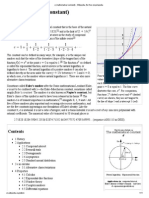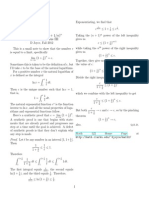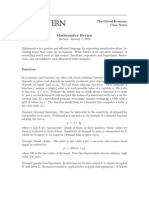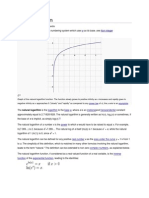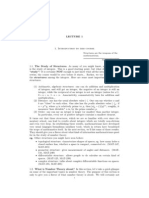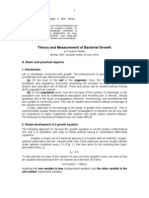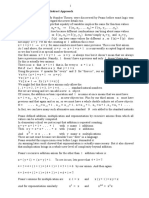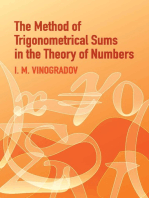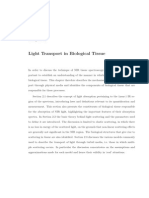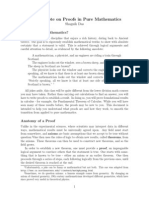E The EXPONENTIAL - The Magic Number Of: Growth
E The EXPONENTIAL - The Magic Number Of: Growth
Uploaded by
YXZ300Copyright:
Available Formats
E The EXPONENTIAL - The Magic Number Of: Growth
E The EXPONENTIAL - The Magic Number Of: Growth
Uploaded by
YXZ300Original Description:
Original Title
Copyright
Available Formats
Share this document
Did you find this document useful?
Is this content inappropriate?
Copyright:
Available Formats
E The EXPONENTIAL - The Magic Number Of: Growth
E The EXPONENTIAL - The Magic Number Of: Growth
Uploaded by
YXZ300Copyright:
Available Formats
e the EXPONENTIAL - the Magic Number of
GROWTH
Keith Tognetti
School of Mathematics and Applied Statistics
University of Wollongong NSW 2522 Australia
12 February 1998
Introduction
This Module is written as a self contained introduction to e, bringing together the main
theorems and important properties of this fundamental constant of natural growth processes.
Not only is an axiomatic treatment given but this is complemented by some theorems that
have been selected for their unexpected beauty.
It assumes only an elementary understanding of integration. Some anecdotes and history
are also included. It will be seen that Eulers gamma constant also comes into the main
theorem and this highlights the intimate interconnection between e, the area under the curve
1
x
, and the the truncated Harmonic series.
The number e is the base of Natural logarithms but it is not the base of Naperian logarithms
as will be seen by glancing at the short historical note on Naperian logarithms in Appendix
A.
1
e owes its importance to mathematics because we come across it in all natural growth
processes.
e like is transcendental and thus it cannot be expressed as the root of a nite polynomial
equation with rational coefcients (go to Appendix Cfor some more about irrationals). If you
read nothing else at least to help you get a feel for arithmetic look at Appendix D, the article
by the Noble Prize winning physicist and sometimes lovable character Richard Feynman.
For a very general, exhaustive and more elementary introduction to e see Maor (Refer-
ences).
Let us begin our description of e by writing down the rst digits
e = 2.7182818284590452353602874...
We immediately note that 1828 is repeated at the beginning. This is rather exceptional as
most of the important constants of mathematics that are irrational have no obvious pattern at
their beginning. However it is almost certain that if we searched through the digits of most of
these numbers we would come across any pattern we liked to dene, as long as the pattern was
not periodic. Thus for example the above list of digits will most certainly occur somewhere
in the expansion of ; although be warned that it might take us a long time to come across
them.
Our rst introduction to the essential nature of e is through a problem in commerce -
Suppose that we have $1 and invest it such that at the end of the rst year we are given $1
interest, thats right 100% interest. Now if instead of the full year we invested our money for
1
10
year it would be only fair that we would get
1
10
of this amount in interest, that is we would
have a total amount of $1 +
1
10
at the end of this rst period.
With simple interest we would get this same amount for each of our ten periods and hence
the total interest would be $1 which is the same as in the rst case. This is the same as saying
that our money has grown from $1 to $2 by an amount of $10
1
10
.
2
Now if we compound our interest the following happens. At the end of the rst
1
10
of
a year we would get $(1 +
1
10
) as before. However at the beginning of the second period
we would invest this amount instead of $1. It follows that at the end of the second period
we would have $(1 +
1
10
)
2
= 1.21 and so on until at the end of the year we would have
$(1 +
1
10
)
10
= $2.5937. Similarly at the end of the year with 100 periods we would have
$(1 +
1
100
)
100
= 2.7048.. and for 1000 periods $2.71692..
From this we nd experimentally that as the number of periods increases the total amount
appears to approach $e. We note that the derivative of (1 +
1
n
)
n
is
(1 +
1
n
)
n
{ln(1 +
1
n
)
1
(1 + n)
}
and that this is positive and decreases to zero as n increases. So this is further evidence that
(1 +
1
n
)
n
converges as n becomes unbounded. However we require the Main Theorem to
prove this conclusively.
You might like to check the following gures for reinvesting on a monthly ($2.63), weekly
($2.69) and daily ($2.71) basis. Even if we reinvest at the end of a half year the amount is
$2.25 which is 12.5% better than simple interest.
This is one of the reasons why banks make such a prot from simple minded customers.
In general if instead of an increase of $1 we had an increase of $r for the year (r is called
the effective annual rate of interest) we can readily show in a similar way to the above that,
with an initial investment of $1, the amount at the end of the year is (1 +
r
n
)
n
and that this
expression approaches e
r
as n increases without bound (see A4, below).
For a rather dramatic example of the absurdity of believing that any economic system can
really sustain exponential growth at even a reasonable" growth rate see Appendix D.
Biological Growth Models
A similar exponential process occurs during the initial growth of many biological organ-
3
isms. This occurs whenever the rate of change is proportional to the size or the number of
the organisms. In this case we nd that for example if y is the length of a root or the number
of cells in an organism then
y = y(0)e
rt
, (1)
where y(0) is the initial value , t is time and r is the intrinsic rate of increase.
This relationship is what is nowgenerally referred to as Malthusian or exponential growth.
However the original growth process referred to by Malthus was actually geometric. Knowing
that
de
x
dx
= e
x
, (from proposition Q4), it is seen that if we differentiate this equation on each
side we get
dy
dt
= y(0)re
rt
= ry. (2)
Hence
r =
dy
dt
y
. (3)
Thus r, which we call the intrinsic rate of increase, is the actual rate of increase
dy
dt
divided
by the total length of, or number of, organisms.
We note that if y were say the number of individuals in a population then
dy
dt
y
, and hence
r, is seen to be the average rate of growth per individual. It is a remarkable fact that, in a
wide range of growth processes in nature and economics, this quantity is constant during the
initial stages of such growth.
From (3) we see that
ln
_
y
y(0)
_
= rt, (4)
where from now on ln x means log
e
x.
(4) may be used as a rough check to test that we have exponential growth. We simply plot
the logarithm of
y
y(0)
against t. If this is a straight line then we have exponential growth.
This exponential growth is hard to deal with intuitively and in practice it is easier to use
the doubling time t
d
dened as the interval of time required for y to double. Then if we
4
consider the population at any time t we will double our population at time t + t
d
. Hence
y(t + t
d
)
y(t)
= 2.
Substituting in our exponential expression (1) we see that this reduces to
exp(rt
d
) = 2, (that is the y(t) cancels out and the expression is thus independent of t).
From this we have
t
d
= ln
2
r
.
If r is measured as a % then this is equivalent to the following - the doubling time is roughly
equal to 70 divided by the interest in % or
td
70
r%
.
This hyperbolic (or reciprocal) relationship is considered to be easier to grasp than the expo-
nential. Thus for example with r = 7% the doubling time is 10yrs, and with r = 10% the
doubling time is 7 yrs.
Other Properties and History
e has all sorts of other interesting properties. Perhaps the most beautiful relationship is
Eulers formula which also involves and i the square root of 1. This is
e
i
= 1.
Part of the beauty of this relationship lies in its unexpected simplicity. Here it is seen that
i brings together e and and unity, three of the fundamental constants of nature, together
with the two operations minus and square root.
We will show in detail in Appendix A that Napiers logarithms are somewhat different to
natural logarithms which use base e. However through formula AA there is a relationship but
Napier was quite unaware of it so his work only implied the use of e.
5
It was not until Bernoulli (Johann I, 1704) that the symbol e and the name exponential
were rst used. This arose because it was necessary to have a way of representing e
x
. In fact
the term Naperian antilogarithm" or e was not used until 1784.
The calculation of logarithms by innite series was carried out by Gregory, Wallis and
Halley (of Comet fame) beginning in the 1670s. It was not until much later (1742) that
William Jones (1675-1749) used exponents to calculate logarithms and allowed present day
methods tobe developed. However it shouldbe emphasisedthat Euler was the rst tointroduce
this concept, and the symbol e, for the base of natural logarithms in an unpublished paper of
1728 (he quoted e to 27 places).
The Layout of this Note
The formal part of this note begins with 2 denitions rstly of a function which is the area
under the curve
1
x
and then a denition for the inverse of this function.
This is followed by a set of propositions (P1, P2 etc) about the logarithmic function
which are developed axiomatically from the denition. Then we present some properties
of the exponential function e
x
(Q1, Q2, Q3) developed axiomatically from its denition as
an inverse of the exponential. Then we show that e
x
is equal to its derivative (Q4). This is
followed by some properties of the functions a
x
and x
a
(Q5, Q6).
Q7 gives a derivation for e which we used in the interest rate problem. Then we derive an
expression for e
x
as a series (Q8). From this we can show that e is irrational (see Appendix
B). Then we give an independent proof of Q7 based on a note by Barnes which has the merit
that it is coupled to Eulers constant. At this stage we digress into Harmonic numbers.
Finally in contrast to the above axiomatic development we offer some alternative proofs
A1, A2, ... A6. These have been selected simply on the basis of their elegance - and by
elegance is meant unexpected simplicity.
6
An Axiomatic Approach
We begin with the denition
LN(x) =
_
x
1
t
1
dt. def 1
It is seen that LN(x) is simply a function of x at this stage. We hope to show that it does
have the properties of a logarithm (see P4 below).
We also dene the inverse of LN(x) as E(y)
LN(x) = y
Hence
E(y) = LN
1
(y) = x. def 2
We hope to show that this inverse function is actually e
y
(see Q3).
Properties of the logarithmic function ln x
We now show that we can derive what we normally consider to be the properties of the
logarithmic function from the above denition, def 1. We present these as a series of lemmas
(minor theorems) or propositions - (it follows that a dillema is a theoremproduced by a stupid
person).
It is not until P4 that we are convinced that LN(x) is in fact ln x.
P1 LN(1) = 0, directly from def 1
P2
dLN(x)
dx
=
1
x
.
This follows directly from def 1 by differentiation under the integral.
P3 The additive relation holds, LN(ab) = LN(a) + LN(b).
7
Proof Let z = LN(ax) then from the chain rule
dz
dx
=
_
1
ax
_
a =
1
x
.
However
d LN(x)
dx
=
1
x
fromP1. Hence as the functions LN(ax) and LN(x) have the same
derivative they must differ only by a constant, that is
LN(ax) = LN(x) + c.
In particular this relationship holds for x = 1 and thus c = LN(a), hence
LN(ax) = LN(x) + LN(a). With x = b we have proved our lemma.
P3a From P3 it follows directly that
_
xy
1
t
1
dt =
_
x
1
t
1
dt +
_
y
1
t
1
dt,
a result which is rather messy to prove directly by integration (is t
1
the only function that
has this property ?)
P4 LN(a
n
) = nLN(a).
This follows by continued application of P3. By substituting
na = y and thus consider-
ing y
n
it follows that ln a
1
n
=
LN(a)
a
. From this it is easy to prove that
LN(a
r
) = r LN(a), where r is rational. And hence as the irrationals are everywhere dense
this result also holds for irrationals.
Note at this stage we see that LN has all the properies of our familiar function log
e
.
P5 ln x is a convex increasing function without bound. It is increasing as its derivative
is always positive. It is convex as its second derivative
1
x
2
is always negative.
It is unbounded as we can always obtain values of ln x > Q where Q is any large quantity
we like to nominate. This is neatly demonstrated as follows. In 3
n
= nln 3. But ln 3 > 1
and thus if x = 3
n
then ln x > n, no matter how large n.
P6
_
ln x dx = x ln x x
8
This follows by integration by parts.
P7 For |x| 1 , it can be shown from Taylors formula that
ln(1 + x) = x
x
2
2
+
x
3
3
. . .
Properties of the Exponential Function e
y
We now dene the inverse of the logarithm of x based simply on the def 1. Again as we
do not know as yet that this is really e
y
so let us call it E(x) = y, where x = ln y.
Q1 E(0) = 1
this is merely acknowledging that ln 1 = 0.
Q2 E(u)E(v) = E(u + v)
Let E(u) = a, E(v) = b, E(u + v) = c then u = ln a, v = ln b, u + v = ln c. It thus
follows that u + v = ln ab is equivalent to ab = c as required.
Denition We now dene e as E(1). def 3.
This is reasonable as if e is the base of our natural logarithm then we must have ln e = 1.
Hence
Q3 E(n) = e
n
.
This follows immediately by the continued application of Q2, with E(u) = E(v) = E(n).
In a similar way to P4 we are able to then show that
Q3a E(r) = e
r
, where r is rational.
Q3b E(x) = e
x
, where x is real. Suppose that x is irrational. Then for example by
using continued fractions we can express x as the limit of a sequence of rationals. Thus the
9
relationship holds for any rational as close to x as we like and thus in the limit it must hold
for x irrational.
Thus we can now for the rst time be convinced that if x = ln y, then y = e
x
.
Q4
de
x
dx
= e
x
.
From P2,
d ln y
dy
=
dx
dy
=
1
y
. Hence as
dx
dy
is always positive we can obtain the derivative of
the inverse as
dy
dx
=
1
dx
dy
= y = e
x
.
Note For any function y = f(x) and its inverse f
1
(y) = x we can see that f(x) is
symmetric to f
1
(x) about the line y = x.
This is equivalent to showing that the point P = (x, y) and the point Q = (y, x) are
symmetric about the line y = x (which has slope 1). Now the slope of the line PQ is
immediately seen to be 1. Also OP = OQ =
x
2
+ y
2
. Hence the result follows. Thus
the graph of e
x
is simply the graph of ln x reected about the line y = x. Thus for example
we see that the slope of e
x
at x = 0 is the same as the slope of ln x at x = 1, namely unity.
Q5 The functions a
x
and x
a
.
Let ln e
f(x)
= g(x), then by (Q3b) e
f(x)
= e
g(x)
and thus f(x) = g(x). Similarly if
h(x) = e
ln f(x)
, taking logs we have ln h(x) = ln f(x), and again f(x) = h(x). Combining
these we see that
f(x) = ln e
f(x)
= e
ln f(x)
.
From this we see that we can always write a as power of e or as a logarithm
a = e
ln a
= ln e
a
.
We can now write our functions very neatly as
y = a
x
= e
xln a
and x
a
= e
a ln x
.
10
Also more directly from the series for e (Q8)
y = e
xln 2
1 + x ln 2
Q6
d(a
x
)
dx
= a
x
ln a and
d(x
a
)
dx
= ax
a1
.
Q7 e
z
= lim
n
_
1 +
z
n
_
n
If f(x) = ln x, then
f
(x) =
1
x
= lim
h0
f(x + h) f(x)
h
,
= lim
h0
1
h
{ln(x + h) ln(x)},
= lim
h0
1
h
ln(1 +
h
x
).
With
1
x
= z
lim
h0
1
h
ln(1 + hz) = z.
Consequently
e
z
= lim
h0
exp[ln(1 + hz)
1/h
] = lim
h0
(1 + hz)
1/h
= lim
n
(1 +
z
n
)
n
, if h =
1
n
.
In particular with z = 1 we have independently shown that
e = lim
n
_
1 +
1
n
_
n
Q8 e
x
= 1 + x +
x
2
2!
+
x
3
3!
+ . . . =
x
j
j!
, for j 0.
This follows directly from the Taylor series expansion about x = 0 for f(x) = e
x
. From
this we have for x = 1
e = 1 + 1 +
1
2!
+
1
3!
+ . . . =
1
j!
, for j 0,
11
which has reasonably fast convergence and so may be used to calculate e
An example Suppose we seek an approximation to y = 2
x
for small x. Fromthe binomial
theorem
y = (1 + 1)
x
= 1 + x +
x(x1)
2!
+
x(x1)(x2)
3!
+
x(x1)(x2)(x4)
4!
+ . . .
= 1 + x(1
1
2
+
1
3
1
4
+ . . .) + x
2
(
1
2
. . .)
1 + x ln 2.
Q9 With Q8 as our denition for e we can now give the
Proof that e is irrational. Assume the opposite that is e =
p
q
where p and q are integers.
Then
p
q
= 1 + 1 +
1
2!
+ . . . +
1
q!
+
1
(q+1)!
+ . . .
(q 1)!p =
_
q! + q! +
q!
2!
+
q!
3!
+ . . .
q!
q!
_
+
1
(q+1)
+
1
(q+1)(q+2)
+ . . .
But the expressions on the left hand side and in brackets are obviously integers, whereas
the remainder
1
(q + 1)
+
1
(q + 1)(q + 2)
+ . . . <
1
(q + 1)
+
1
(q + 1)
2
+ . . . =
1
(q+1)
1
1
(q+1)
=
1
q
1.
Thus for our original assumption to be valid we require an integer to be equal to an integer
plus a number less than one. As this is absurd our original asssumption is invalid and e must
be irrational.
Theorem M To show that
e = lim
n
_
1 +
1
n
_
n
.
This presentation is based on Barnes, C. (1984). As a by-product it establishes the
expression for Eulers constant , which is dened below. Alternative proofs are given in Q7,
and A1.
Proof From P6
_ 1
n
1
(n+1)
ln xdx =
1
n(n + 1)
_
ln
(n + 1)
n
n + 1
1
_
. (M1)
12
Also we know from the mean value theorem that there exists a c
n
somewhere in the range
of integration (that is
1
(1+n)
< cn <
1
n
) where
_ 1
n
1
(n+1)
ln xdx =
_
1
n
1
(1 + n)
_
ln c
n
. (M2)
From (M1) and (M2)
ln
_
(n + 1)
n
n
n+1
_
1 = ln c
n
,
from which
ln
_
_
(n+1)
n
n
n+1
c
n
_
_
= 1.
Hence
e =
(n+1)
n
n
n+1
c
n
,
or
e =
_
1 +
1
n
_
n
1/nc
n
. (M3)
Now let a
n
=
1
(nc
n
)
. Then because of the range of c
n
we have
1 < a
n
< 1 +
1
n
. (M4)
Hence we have the remarkable result that for all positive n
e = a
n
_
1 +
1
n
_
n
. (M5)
As a
n
> 1 it follows immediately from (M5) that for example
e >
_
1 +
1
2
_
2
= 2
1
4
.
Also because a
n
is in the above sandwich (M4), in the limit as n , a
n
= 1 and thus
our theorem is proved.
Denition We dene Eulers constant as
= lim
n
__
1 +
1
2
+
1
3
+ . . . +
1
n
_
ln(n + 1)
_
.
13
Corollary M
<
2
6
= 1.64..
Proof
From (M5)
e = a
n
_
1 +
1
n
_
n
=
a
n
(n + 1)
n
n
n
.
Thus taking logarithms
1 = ln a
n
+ n{ln(n + 1) ln n},
or
1
n
= ln a
1/n
n
+ ln(n + 1) ln n.
From this by substituting successive values 1, 2, 3, ... for n, we obtain the equations
1 = ln a
1
+ ln 2 ln 1
1
2
= ln a
1/2
2
+ ln 3 ln 2
1
3
= ln a
1/3
3
+ ln 4 ln 3
..........
1
n
= ln a
1/n
n
+ ln(n + 1) ln n.
Summing
1 +
1
2
+
1
3
+ . . . +
1
n
ln(n + 1) = ln a
1
a
1/2
2
a
1/3
3
. . . a
1/n
n
. (M6)
We note that the continued product on the right hand side is increasing in n. Also from
(M4) a
n
< 1 +
1
n
, hence
ln a
1
a
1/2
2
a
1/3
3
. . . a
1/n
n
= ln a
1
+
1
2
ln a
2
+ . . .
1
n
ln a
n
,
14
< ln
_
1 +
1
1
_
+
1
2
ln
_
1 +
1
2
_
+ . . . +
1
n
ln
_
1 +
1
n
_
.
Furthermore from (M4), a
n
> 1. Thus from (M5), 1 <
_
1 +
1
n
_
n < e. Hence ln 1 <
ln
_
1 +
1
n
_
n
< ln e, or 0 < ln
_
1 +
1
n
_
< 1/n. Substituting this into the inequality
ln a
1
a
1/2
2
a
1/3
3
. . . a
1/n
n
< 1 +
1
2
2
+
1
3
2
+ . . .
1
n
2
.
But it can be easily shown that the innite series 1 +
1
2
2
+
1
3
2
+ . . . is convergent. In fact
it has the value
2
6
= 1.644 (see Knuth - would you believe that if we select two integers at
random the probability that they dont have a common factor is
6
2
). Thus as the continued
product is bounded, the l.h.s. of (M6) is bounded and hence < 1.64 . . .
Note - It can be shown numerically that = 0.5772 . . ..
Eulers constant features widely in many diverse areas of mathematics such as number
theory and modied Bessel functions. Also Knuth (1973) (with a rather more introductory
account of this in Graham, Knuth and Patashnik) gives an interesting treatment of the above
series for the summation of the rst n reciprocals which he denes as
H
n
= 1 +
1
2
+
1
3
+
1
4
+ . . . +
1
n
=
1
k
, k n,
where H stands for harmonic number. Hence the innite series H
is the harmonic series.
It follows that for large values of n, H(n) approaches ln n. It should be noted that it
is only for very large values that the term can be discarded - for example it takes more than
10
43
terms for H(n) to exceed 100.
A more robust formulation which is a reasonable approximation for smaller values of n
is
lim
n
H(n) = ln n + +
1
2n
1
12n
2
+
1
120n
4
s,
where 0 < s <
1
256n
6
and
A Connection Between the Harmonic Number and the Area under the curve y =
1
x
, for
x > 1 can be developed from rst principles as follows. By simple graphical construction
15
the area under this curve, for values of x between x = 1 and x = n is less than the sum of
the n rectangles constructed, rstly on the base x = 1 to 2 and of height 1(=
1
1
) and then on
the base x = 2 to 3 and of height
1
2
and so on until we construct the last rectangle on the base
x = n to n + 1 of height
1
n
. That is ln n < H
n
.
Similarly the area under this curve is greater than the sum of the of the n 1 rectangles
constructed rstly on the base x = 1 to 2 and of height
1
2
and then on the base x = 2 to 3 and
of height
1
3
and so on until we construct the last rectangle of height
1
n
on the base x = n 1
to n. That is ln n > H
n
1.
This gives us the intuitive basis for the entry into our axiomatic treatment beginning with
def 1.
Now we have simply shown that 1 + ln n > H
n
and this gives a better upper bound, that
is < 1 than Corollary M. So why have we bothered with the corollary? Well it does give
some other rich relationships and it connects nicely with our main theorem. So it just could
be valuable at a some later stage and that is what the essence of creative mathematics is all
about - stumbling upon unexpected connections with other areas.
A comment : The Generalised Harmonic Number
H
(r)
n
= 1 +
1
2
r
+
1
3
r
+
1
4
r
+ ... +
1
n
r
=
1
k
r
, k n.
For any value of r > 1, H
(r) is convergent. H
is just convergent in the sense that if r
is just a touch greater than 1 the series converges. Hence we woud expect from this that H
n
increases very slowly with n as we have found out above.
H
(r) is the corresponding innite series is the Rieman Zeta function and is usually
represented by (r). Now if we attempt to solve (r) = H
(r)
= 1 for r, it is seen that the
roots must be complex. The Riemann hypothesis makes the remarkable claim that all such
roots lie along the one vertical straight line in the complex plane such that their real parts are
equal to
1
2
.
16
Alternative Proofs
With such an important constant as e one nds that there are many rich relationships
amongst the various associated expressions. Consequently it would not be expected that any
particular axiomatic development would present the most elegant proofs. So we include some
of these.
A1 To prove e = lim
n
_
1 +
1
n
_
n
Let y = lim
n
_
1 +
1
n
_
n
then
ln y = lim
n
nln
_
1 +
1
n
_
= lim
n
ln
_
1 +
1
n
_
1
n
.
As this is in the form 0/0 we use lHospitals rule and differentiate
ln y = lim
n
1
n
2
_
1 +
1
n
_
1
n
2
,
= 1,
and this shows that y = e as required.
Notice that we have assumed P2, that is that we know the derivative of a logarithm.
A2 Let f be a function such that for every pair of reals x, y
f(x + y) = f(x)f(y). (M).
We will say that f satises the multiplicative property.
Then we require to prove the following:
if f(x) is continuous and is not identically zero, and f(1) = a > 0, and furthermore f(x)
satises the multiplicative property then
f(x) = a
x
for all x.
17
Proof Now f(x) = f{(x 1) + 1} = f(x 1)f(1).
Hence if f(1) = 0 then f(x) = 0 for all x. Hence we assume the opposite.
Suppose f(1) = a > 0. Then again
f(x) = f(x 1)f(1) = f(x 1)a = f(x 2)a
2
= f{x (x 1)}a
x1
= f(1)a
x1
= a
x
.
Note that this shows that (M) holds only when x is integer as we subtracted integers from
x to obtain 1. To prove this for x rational say
m
p
where m and p are integers we rstly write
1 =
1
p
+
1
p
+ . . .
1
p
, that is p terms.
Thus applying (M) repeatedly
f(1) =
_
f
_
1
p
__
1/p
.
Also
f
_
m
p
_
= f
_
1
p
+
1
p
+ . . .
1
p
_
, where we now have m terms
=
_
f
_
1
p
__
m
= {f(1)}
m/p
= a
m/p
or f(x) = a
x
, as required for x rational. It follows that as the rationals are everywhere dense
that this result also holds for real functions provided that f(x) is continuous.
A3 We wish to show that the solution to
dy
dx
= y where y(0) = 1,
has the multiplicative property of A2.
That is we claim that y(x + v) = y(x)y(v).
Proof Let z(x) = y(a + x). Then z
(x) = z(x).
Now
d
dx
y(x)
z(x)
=
zy
y
z
2
=
zyzy
z
2
= 0.
18
Hence
y(x)
z(x)
= K, a constant, or
y(x) = Kz(x) = K y(a + x).
Hence as y(0) = 1, with x = 0 we have K =
1
y(a)
. From this
y(a + x) = y(a) y(x),
as required.
We also know independently that y(x) has a unique solution and hence the multiplicative
property is unique.
A4 Assuming A1, e = lim
t
_
1 +
1
t
_
t
, we wish to show that
e
x
= lim
n
_
1 +
x
n
_
n
.
We note rstly that t may be real, that is it does not have to range over the integers for A1
to be valid.
Now
_
1 +
x
n
_
n
=
_
_
1 +
x
n
_
n/x
_
x
=
_
_
1 +
1
t
_
t
_
x
with t =
n
x
. The result then follows by taking the limit.
A5 Let f(x) = b
x
Then from Q6
f
(x) = b
x
ln b and thus f
(0) = ln b
But from rst principles
f
(x) = lim
h0
b
x+h
b
x
h
.
Thus with x = 0
ln b = lim
h0
b
h
1
h
.
19
The relationship A5 automatically resolves the apparent conict with the expression
_
b
a
x
u
dx =
b
u+1
a
u+1
(u + 1)
,
when u 1, say 1+h, and with a = 1, it is seen fromthe above limit that this approaches
ln b as required when h 0
A6 Using Q8 to dene e
x
we wish to establish the multiplicative property.
Now
e
u
e
v
=
m=0
u
m
m!
m=0
v
m
m!
But it is known that (the Cauchy convolution form for the product of two series)
n=0
a
n
n=0
b
n
=
n=0
c
n
where c
n
=
n
k=0
a
nk
b
k
.
Hence
e
u
e
v
=
n=0
n
k=0
u
nk
(n k)!
v
k
k!
,
and by the binomial expansion
(u + v)
n
=
n
k=0
n!u
nk
v
k
(n k)!k!
,
from which
e
u
e
v
=
n=0
(u + v)
n
n!
= e
u+v
.
References
Barnes, C. Eulers Constant and e", Am Math Monthly Aug 84, p428.
Coolidge, J.L. The Mathematics of Great Amateurs", (Oxford, 1949).
20
Eves, H. Great Moments in Mathematics", (Mathematical Association of America).
Knuth, D.E. The Art of Computer Programming", (Section 1.2.7 Harmonic Numbers p73)
vol 1 (2nd edition) 1973.
Graham, Knuth, D. and Patashnik, O. Concrete Maths" - (Addison Wesley - 2nd Edition
1994) - Concrete is short for continuous plus discrete).
Maor, Eli. e: The Story of a Number" (Princeton University Press, 1994).
Struik, D.J. A Source Book in Mathematics 1200-1800", (Harvard, 1969).
APPENDIX A
Napier (1550-1617), a Scottish Laird, was one of the great amateurs of mathematics.
He began to develop logarithms in 1594 and worked on this task until his death. Amongst
other things he was obsessed with demonstrating that the then reigning pope was the anti
christ. In fact Napier believed that his now forgotten work on the Apocalypse of St John
was his greatest service to mankind and this belief was bolstered by the fact that his book on
this subject went through 20 editions. Newton had a similar obsession with the Apocalypse
which might indicate (at least to a statistician) that if we started off budding young geniuses
on this study it could lead to great mathematical breakthroughs.
Briggs was the rst occupant of a chair of mathematics in Britain. This was in Geometry at
Gresham College in London. Later he was the rst to occupy the Savillian chair of geometry
at Oxford. He extended Napiers work to base 10 and went to visit him after hearing of his
wonderful discovery and communicating with him. On the interminable journey by coach
to Edinburgh Briggs recorded some of his thoughts in his diary - how tall a forehead must
his nobleman possess in order to house the brains that have discovered so remarkable an
invention and so on. His arrival in Edinburgh was very much delayed and Napier confessed
to a friend Ah John, the Professor will not come".
21
At that very moment a knock was heard at the gate and the Professor was ushered into
the noblemans presence. For almost a quarter of an hour each man beheld the other without
speaking a word. Then Briggs said My Lord, I have undertaken this long journey purposely
to see your person, and to learn by what engine of wit or ingenuity you came rst to think of
this most excellent help in astronomy. But, my lord being by you found out, I wonder nobody
found it out before when now known it appears so easy."
In understanding the importance the work of Napier it should be realised that the math-
ematics of his day was very decient in both concepts and notation. Not only was there
no concept of logarithm but the concept of powers was only emerging and for example the
symbol x
n
as a shorthand for x x . . . had not been introduced. It is of interest to note that
only because of the authority of Napiers work did the decimal notation became generally
accepted, thus = 2.083 instead of the clumsy 2
83
1000
.
The description of the technique he used for calculating his logarithms" and tables of such
logarithms" are best described in his second book which was rst published in Latin in 1619.
This was translated from the Latin into English and published by Blackwood, Edinburgh in
1889, with the title The Construction of the Wonderful Canon of Logarithms".
Curiously enough although the term logarithm occurs in the title the text uses only the
term articial number. As we will show shortly his logarithm is not what we now know as
the natural logarithm. Detailed accounts of his work are contained in Struik, D.J. (1969) and
Coolidge, J.L. (1949). Unfortunately his presentation is almost unintelligible to a present
day mathematician and although his work is one of the great moments in mathematics it is in
effect an ugly dead end, similar to the dead end taken in the pursuit of the Ptolemaic system
of epicycles as a description of planetary motion.
The basis for his idea was probably seen in the formula
sin Asin B =
1
2
{cos(A B) cos(A + B)},
which was certainly known in Napiers time.
22
Now Stifel had earlier in Arithmetica Integra" (1543) recorded the rst observation that
the terms of the geometric progression 1, r, r
2
, . . . correspond to the arithmetic progression
0, 1, 2, . . .. Stifel also noted that multiplication of two terms in this g.p. yields a term
whose exponent is in effect the sum of the corresponding two terms in the a.p. Similarly
he implied that division was coupled with subtraction of exponents and he was even able
to manipulate negative and fractional exponents. All this was recorded without any special
mathematical notation. It appears that Napier did know of this work but, incredibly, failed to
see the relevance of exponents on his logarithms. If he had picked it up it would most surely
have accelerated the development of mathematics.
Because of his interest in spherical trigonometry he based his work on the logarithms of
sines however let us warn you now that his use of the terms radius and sine simply referred to
intervals on a straight line (AZ and DZ in the following). In effect he said the following. Lay
out two lines AZ and A
. Measuring in the direction from Z to A, the point A corresponds
to what Napier calls the sine of 90 degrees which he has approximated by 10
7
as he could
not of course represent innity. Along A
he lays out the corresponding logarithms" of
these sines, thus he has A
representing 0, or in his notation, logarithm" 10
7
= 0. Now he
lays out points B, C, D, E, along AZ and, the points B
, C
, D
, E
, . . . he lays out along
A
. It will be shown that A
corresponds to his logarithm of AZ, A
corresponds to
his logarithm of BZ and so on.
Now he has a point initially at A moving along AZ, with a velocity proportional to its
distance from Z and this corresponds to a point moving along A
with constant velocity
equal to the initial velocity of the other point when it is at A. Suppose that on AZ each of the
intervals AB, BC, CD. . . are traversed in the same small interval t.
Napier assumed that if t is small enough then the velocity of the point throughout the
interval is constant and equal to the velocity at the beginning of the interval. From this the
intervals AZ, BZ, CZ, . . . form a decreasing g.p. as we will now demonstrate. Let the
velocity of the point throughout the interval whose initial distance is y from B be v, in the
23
direction AB, such that v = ky. Thus for example
DZ = CZ CD.
The velocity of the point at C is k(CZ). This is now assumed constant over the interval
CD. Hence CD = k(CZ)t. From which
DZ = CZ k(CZ)t = CZ(1 kt).
From this it is seen that any length is a constant times the preceeding length and our result
follows. Initially Napier took kt to be
1
10
7
. He took the distances A
, A
, . . . to be 1,2,3,
. . ., however any arbitrary increasing a.p. would be just as satisfactory.
Translating the above into present day calculus, which was of course unavailable to Napier,
we consider the motionof twoparticles the rst whichwe will call P, travellingalongAB. The
second particle P
(the image of P) we will consider travelling along A
. Let B = a(= 10
7
),
PZ = y and let AP
= x. Suppose the rst particle is at point A initially (at time t = 0) that
is y(0) = a. Then its velocity at this point is ka. Napier then assumed that this is the same
as the constant velocity of the point P
moving along the line A
. From this the velocity of
P is
d
dt
(a y) =
dy
dt
= ky. From this we know that y = ae
kt
, and that kt = ln
a
y
where
ln is the natural log to base e. Now if A
= x, then as the point moves along the line A
with the constant velocity a, then x = kat.
Napier dened this to be the Naperian logarithm which we will call Nap y. Thus we
have
Nap y = a ln
a
y
= a ln a a ln y
= ln
_
a
y
_
a
= a log
1/e
y
a
. (AA)
In the particular case where y = a, Nap a = 0 which satises Napiers requirement that
the point A correspond to log zero. Of course if a = 1, then Nap y is simply
ln y or log
1/e
y.
24
It should be emphasised that Napiers logarithmNap is actually the natural logarithmof
_
a
y
_
a
and thus it is inadvisable to couple the two names together.
We note that
Nap zy = a ln
a
zy
= a(ln a ln z ln y) = a ln a a(ln z + ln y),
Nap
z
y
= a ln
ay
z
= a(ln a + ln y ln z)
Nap z + Nap y = 2a ln a a(ln z + ln y) = 2a ln a a ln(z + y),
Nap z Nap y = a(ln y ln z)
and thus
Nap zy = (Nap z + Nap y) a ln a.
Nap
z
y
= (Nap y Nap z) + a ln a.
Consequently Nap does satisfy the additive rule directly if we subtract a constant. Napier
also noted that if
a
b
=
c
d
then
Nap a Nap b = Nap c Nap d.
Napiers logarithms were certainly used widely throughout Europe and this made Napier
very famous. Whether he was renumerated for his great achievments is unknown. Laplace
summed up their impact by saying that they by shortening the labours of an astronomer
double his life".
Briggs was very much obliged to Napier for his suggestion to have log 1 = 0 and that the
logarithm of 10 should be a power of 10 (not necessarily unity) but even with this beginning
they did not use the notation of exponents.
APPENDIX B
25
Note on Rationals and Transcendentals
It will be recalled that a number is rational if it can be represented as the ratio of two
integers, otherwise the number is irrational. Furthemore if an irrational can be represented
as the root of a polynomial then it is an algebraic irrational, otherwise it is a transcendental.
Hence
2 is irrational as it cant be represented as the ratio of two integers. But it is not
transcendental as it is the root of the polynomial x
2
2 = 0. On the other hand it can be
shown that the irrational e cannot be represented as the root of such an equation no matter
how large the degree and hence it must be transcendental.
It was rst shown in 1761 by Lambert (1728-77) that both e and were irrational. It took
over a century to show that these numbers were transcendental. Hermite (1822-1905) proved
that e was transcendental in 1873 (whilst Lindemann (1852-1939) proved in 1882 that was
transcendental).
Hermite (1822-1901) also showed that e
y
was irrational for rational y but it was not until
1929 that Gelfond showed that e
was irrational. It is interesting to note that
e
has still
not been shown to be irrational. Even more surprising is that the irrationality of , Eulers
constant (see the main theorem), is still undecided! For the proof that e is irrational see Q9.
26
APPENDIX C
The Age Dependent Population Model
We nowconsider a fairlyrealistic populationmodel inwhichthe birthanddeathparameters
are age dependent. In what follows all individuals are females, t refers to time and x to age.
So we dene
b(x)x =the probability that an individual of age x gives birth in the interval x to x+x.
P(x) = the survivor function - which is the probability that a new born individual will
survive beyond x.
B(t) = total birth rate.
Now, individuals of age x to x + x must have been born at t x, t x x and
survived a period t x. That is B(t x)P(x)x must have survived to age x and thus the
contribution to the total birth rate is B(t x)P(x)b(x)dx.
Summing over all ages
B(t) =
_
0
B(t x)b(t)P(t)dt
Now this is called an integral equation in the unknown B(t) as this term occurs within the
integral as well as on the left hand side.
It is known that for small t the solution is often the sum of many exponentials. What is
more remarkable is that the solution when t is large always approaches the single exponential
Ae
rt
,
where r is the largest root of
_
0
e
rt
b(t)P(t)dt = 1.
This is the justication for claiming that e is indeed the magic number of growth!
27
APPENDIX D
The following is an extract from the book Feynman, Richard P., SURELY YOURE
JOKING, MR. FEYNMAN!" Adventures of a Curious Character, as told to Ralph Leighton.
Ed. Published by Edward Hutchings, W.W Norton and Company, New York, London. (also
in softback by Bantam Books, New York).
Richard Feynman who died in 1989, apart from being one of the most original thinkers
in and out of physics since the last world war, was undoubtedly one of the great eccentrics of
the American University scene. Unlike many European University eccentrics many of whom
had a cruel streak he was very lovable and made fun of his pompous targets in a gentle way.
Working on the atom bomb at Los Alamos he communicated with his wife in code and
opened all the top security safes - he wrote up some of his Nobel prize winning physics in
topless bars and had all sorts of remarkable encounters with gangsters - his unique ability
to smash through cant and cant, and go directly to the core of a problem allowed him as a
member of the commission for the Challenger disaster to demonstrate very dramatically that
the cause was simply due to an O-ring failing because of low temperatures.
On his death his students at Caltech raised a large banner inscribed with their nal testi-
mony to him - We love you Richard".
So if you cant do the sums that follow as quickly as Feynman, console yourself with the
awareness that you are being given a lesson from a genius.
By the way the Marchant he refers to is a very old fashioned semi mechanical calculator
where you had to rotate a handle to do multiplications.
The following tells you something about e but even more importantly it tells you a great
deal about the difference between being able to merely manipulate numbers, and understand-
ing the nature of numbers. Whatever you do buy the book, read it for enjoyment and at the
same time you will learn about one of the most important lessons that there is to know in
28
science: the pleasure of playing with a project. The value of this neglected activity is shown
as follows - Feynman is in the cafeteria and observes that a plate thrown by a student wobbled
in an interesting way. He then returns to his ofce and played around" with some equa-
tions relating to wobbles with no thought about a research plan The diagrams and the whole
business that I got the Noble prize for came from that piddling around with the wobbling
plate."
LUCKY NUMBERS
One day at Princeton I was sitting in the lounge and overheard some mathematicians
talking about the series for e
x
, which is 1 + x +
x
2
2!
+
x
3
3!
+ . . .. Each term you get by
multiplying the preceding term by x and dividing by the next number. For example, to get
the next term after x
4
/4! you multiply that term by x and divide by 5. Its very simple.
When I was a kid I was excited by series, and had played with this thing. I had computed
e using that series, and had seen how quickly the new terms became very small. I mumbled
something about how it was easy to calculate e to any power using that series (you just
substitute the power for x).
Oh yeah ?" they said, Well, then, whats e to the 3.3?" said some joker - I think it was
Tukey.
I say, Thats easy. Its 27.11."
Tukey knows it isnt so easy to compute all that in your head. Hey! Howd you do that?"
Another guy says, You know Feynman, hes just faking it. Its not really right."
They go to get a table, and while theyre doing that, I put on a fewmore gures: 27.1126,"
I say.
They nd it in the table. Its right! But howd you do it!"
29
I just summed the series."
Nobody can sum the series that fast. You must just happen to know that one. How about
e to the 3?"
Look," I say. Its hard work! Only one a day!"
Hah! Its a fake!" they say, happily.
All right," I say, Its 20.085."
They look in the book as I put a few more gures on. Theyre all excited now, because I
got another one right.
Here are these great mathematicians of the day, puzzled at how I can compute e to any
power! One of them says, He just cant be substituting and summing - its too hard. Theres
some trick. You couldnt do just any old number like e to the 1.4."
I say, Its hard work, but for you, OK. Its 4.05."
As theyre looking it up, I put on a few more digits and say, And thats the last one for
the day!" and walk out.
What happened was this: I happened to know three numbers - the logarithm of 10 to the
base e (needed to convert numbers from base 10 to base e), which is 2.3026 (so I knew that e
to the 2.3 is very close to 10), and because of radioactivity (mean-life and half-life), I knew
the log of 2 to the base e, which is .69315 (so I also knew that e to the .7 is nearly equal to 2).
I also know e (to the 1), which is 2.71828.
The rst number they gave me was e to 3.3, which is e to the 2.3 - ten - times e, or 27.18.
While they were sweating about how I was doing it, I was correcting for the extra .0026 -
2.3026 is a little high.
I knew I couldnt do another one; that was sheer luck. But then the guy said e to the 3:
30
thats e to the 2.3 times e to the .7, or ten times two. So I knew it was 20 something, and
while they were worrying how I did it, I adjusted for the .693.
Now I was sure I couldnt do another one, because the last one was again by sheer luck.
But the guy said e to the 1.4, which is e to the .7 times itself. So all I had to do is x up 4 a
little bit!
They never did gure out how I did it.
APPENDIX E
From the book Memorabilia Mathematica" by Robert Edouard Moritz (Mathematical
Association of America). (see review by Keith Tognetti, Gazette, Austr. Math. Soc., Vol 23
No 4 , Nov 96, p177).
This is an unaltered and unabridged republication of the rst edition of 1914. The main
purpose is to seek out exact statements and references to famous passages about mathematics
and mathematicians - this is the work of a genuine philomath which in more enlightened times
meant simply a lover of learning (from the Greek mathema which originally meant learning
- only later was it taken over to apply only to maths).
Surely even an economic rat can see that there is something wrong with his sums when
he reads this.
(Item 2130) If the Indians hadnt spent the $24". In 1626 Peter Minuit, the rst governor
of New Netherland, purchased Manhattan Island from the Indians for about $24 . . . assume
for simplicity a uniform rate of 7% (for the 280 years, this percentage is about average for
the stockmarket when it is not crashing) then the value in 1906 would be 24 1.07
280
= more
than $4,042 million. This turned out to be enough to buy the entire borough back again!
Furthermore if the Indians came to collect on their money today its value would be over
2 trillion dollars!!!
31
So much for sustainable interest rates and economics being an exact science.
32
You might also like
- White Paper To Mok - FINAL-1Document26 pagesWhite Paper To Mok - FINAL-1William Mook67% (3)
- Investigative Report On The Covid-19 Pandemic and Its Relationship Tu Sars-Cov-2 and Other Factors (Claire Edwards)Document186 pagesInvestigative Report On The Covid-19 Pandemic and Its Relationship Tu Sars-Cov-2 and Other Factors (Claire Edwards)Éditions DédicacesNo ratings yet
- Student Exploration: Photoelectric Effect: JosephDocument6 pagesStudent Exploration: Photoelectric Effect: JosephJoey Minogue100% (1)
- Pharmacognosy & Phytochemistry A Comprehensive Approach 2nd Ed. - SL DeoreDocument14 pagesPharmacognosy & Phytochemistry A Comprehensive Approach 2nd Ed. - SL DeoreHarish Kakrani40% (5)
- Sample POMRDocument4 pagesSample POMRJeffrey RamosNo ratings yet
- E The EXPONENTIAL - The Magic Number Of: GrowthDocument32 pagesE The EXPONENTIAL - The Magic Number Of: Growth202022009No ratings yet
- E (Mathematical Constant)Document11 pagesE (Mathematical Constant)Bodhayan PrasadNo ratings yet
- Mathematical Meaning of 'E'Document4 pagesMathematical Meaning of 'E'mikeoniceNo ratings yet
- Understanding Euler's Constant The Easy WayDocument4 pagesUnderstanding Euler's Constant The Easy Wayanurag_mnr028850No ratings yet
- The Number Concept, True its Definition and The Division by ZeroFrom EverandThe Number Concept, True its Definition and The Division by ZeroNo ratings yet
- Arsdigita University Month 2: Discrete Mathematics - Professor Shai Simonson Lecture NotesDocument28 pagesArsdigita University Month 2: Discrete Mathematics - Professor Shai Simonson Lecture NotesImanuddin AmrilNo ratings yet
- LEGADM by Syeda Amna BatoolDocument6 pagesLEGADM by Syeda Amna BatoolAmna NaqviNo ratings yet
- How Euler Discovered The Zeta Function: Keith DevlinDocument4 pagesHow Euler Discovered The Zeta Function: Keith DevlinKush BhattacharjeeNo ratings yet
- E (Mathematical Constant)Document10 pagesE (Mathematical Constant)Giannis PardalisNo ratings yet
- Arithmetic Progression - Wikipedia PDFDocument17 pagesArithmetic Progression - Wikipedia PDFMohalidin EsmaelNo ratings yet
- Arithmetic Progression - Wikipedia PDFDocument17 pagesArithmetic Progression - Wikipedia PDFMaureen FloresNo ratings yet
- Multiple Regression InterpretationDocument13 pagesMultiple Regression InterpretationMuhammad HarisNo ratings yet
- General Mathematics 5 (Exponential Functions)Document48 pagesGeneral Mathematics 5 (Exponential Functions)Kevan jaymes KatipunanNo ratings yet
- IMOTC AlgebraDocument26 pagesIMOTC AlgebraShamim Akhtar100% (2)
- Second Lecture Math100Document15 pagesSecond Lecture Math100Thích Toán HọcNo ratings yet
- MITOCW - MITRES2 - 002s10nonlinear - Lec10 - 300k-mp4: ProfessorDocument24 pagesMITOCW - MITRES2 - 002s10nonlinear - Lec10 - 300k-mp4: ProfessorBastian DewiNo ratings yet
- Leonhard EulerDocument5 pagesLeonhard EulerJamaica Rose BalbinNo ratings yet
- Math Lecture Notes 1Document3 pagesMath Lecture Notes 1revilyn reguyalNo ratings yet
- Gen Math Week 5 8 WITH LASDocument56 pagesGen Math Week 5 8 WITH LASEdison MontemayorNo ratings yet
- Introduction To Mathematical EconomicsDocument164 pagesIntroduction To Mathematical Economics.cadeau01No ratings yet
- E As The Limit of (1 + 1/n) Math 122 Calculus IIIDocument1 pageE As The Limit of (1 + 1/n) Math 122 Calculus IIIsiddharth.nt9234No ratings yet
- Continued Fractions - Sacred GeometryDocument13 pagesContinued Fractions - Sacred Geometryluca pilottiNo ratings yet
- Exponential Growth and Decay: Differential Equations: 9.1 Observations About The Exponential FunctionDocument15 pagesExponential Growth and Decay: Differential Equations: 9.1 Observations About The Exponential FunctionMhe Ann GiganteNo ratings yet
- M106 Worktext Ch2.Lesson 1Document8 pagesM106 Worktext Ch2.Lesson 1Raymond GarciaNo ratings yet
- Mathematicsforbioscientists Chapter1Document31 pagesMathematicsforbioscientists Chapter1Neural Spark Physics CieNo ratings yet
- Calculus II: Lectures On Differential Equations: Kimball Martin December 9, 2015Document16 pagesCalculus II: Lectures On Differential Equations: Kimball Martin December 9, 2015Marvin LabajoNo ratings yet
- Euler's Formula. The Most Beautiful Mathematical - by Z - Ai - The Startup - MediumDocument20 pagesEuler's Formula. The Most Beautiful Mathematical - by Z - Ai - The Startup - MediumVitaly Vitaly100% (1)
- Mathematics Review: The Global Economy Class NotesDocument10 pagesMathematics Review: The Global Economy Class NotesAshish MehtaNo ratings yet
- Natural LogarithmDocument13 pagesNatural Logarithmmarvin125No ratings yet
- Litvin Python Chapter 04Document22 pagesLitvin Python Chapter 04Omar AtreidesNo ratings yet
- On Euler'S Number E: Avery I. McintoshDocument5 pagesOn Euler'S Number E: Avery I. McintoshFrédéric Bambus MoresmauNo ratings yet
- Case Study:: If The Solution To A Problem Is Easy To Check For Correctness, Is The Problem Easy To Solve?Document5 pagesCase Study:: If The Solution To A Problem Is Easy To Check For Correctness, Is The Problem Easy To Solve?arunNo ratings yet
- Billions Pi DigitsDocument8 pagesBillions Pi DigitsPater FroschNo ratings yet
- Lecture 1 Introduction To Number Theory, MAT115ADocument6 pagesLecture 1 Introduction To Number Theory, MAT115ALaura Craig100% (1)
- MathReview 1Document34 pagesMathReview 1resperadoNo ratings yet
- T8s34aeev - Exponential and Logarithmic FunctionsDocument26 pagesT8s34aeev - Exponential and Logarithmic FunctionsBlessie LazaroNo ratings yet
- MITOCW - MITRES - 6-007s11lec03 - 300k.mp4: ProfessorDocument16 pagesMITOCW - MITRES - 6-007s11lec03 - 300k.mp4: ProfessorsivatejamundlamuriNo ratings yet
- Abstract AlgebraDocument200 pagesAbstract Algebraomerstark1No ratings yet
- 1 Mathematical Models of The Population Growth: N MN, N (0) N, DDocument4 pages1 Mathematical Models of The Population Growth: N MN, N (0) N, DJUNIORNo ratings yet
- MAS331notes1 METRIC SPACES SHEFFIELDDocument5 pagesMAS331notes1 METRIC SPACES SHEFFIELDTejas PatelNo ratings yet
- Theory and Measurement of Bacterial GrowthDocument11 pagesTheory and Measurement of Bacterial GrowthBi Anh100% (1)
- 5 0 Applications First - Order - OdesDocument16 pages5 0 Applications First - Order - OdesDelos Santos, Jayson C.No ratings yet
- mst124 Unit11 E1i1 PDFDocument77 pagesmst124 Unit11 E1i1 PDFSam Adams100% (1)
- 3E04 - Mass Transfer 2 Term, 2011 A Crash Course in Differential EquationsDocument4 pages3E04 - Mass Transfer 2 Term, 2011 A Crash Course in Differential EquationsReb19900% (1)
- Discrete Math Truth TablesDocument11 pagesDiscrete Math Truth TablesnatashkanNo ratings yet
- Math ReviewerDocument15 pagesMath ReviewerJoshua Martin Zamora SalvadorNo ratings yet
- Maple: Objective: After Reading This Chapter, You Will Solve Mathematical Problems Using MapleDocument5 pagesMaple: Objective: After Reading This Chapter, You Will Solve Mathematical Problems Using MaplerockydarkNo ratings yet
- Collatz Conjecture An Abstract ApproachDocument6 pagesCollatz Conjecture An Abstract ApproachHavas JanosNo ratings yet
- Uses of Elementary Calculus Arising in EconomicsDocument21 pagesUses of Elementary Calculus Arising in EconomicsGautu GubbalaNo ratings yet
- On Using These Lecture NotesDocument6 pagesOn Using These Lecture Noteskfoster5126No ratings yet
- Ivp PDFDocument61 pagesIvp PDF王子昱No ratings yet
- The Method of Trigonometrical Sums in the Theory of NumbersFrom EverandThe Method of Trigonometrical Sums in the Theory of NumbersNo ratings yet
- Biomedical Optics II 生物医学光学II: Monte Carlo Modeling of Photon TransportDocument59 pagesBiomedical Optics II 生物医学光学II: Monte Carlo Modeling of Photon TransportYXZ300No ratings yet
- Chapter 2Document25 pagesChapter 2YXZ300No ratings yet
- ProofsDocument5 pagesProofstemp_undergradNo ratings yet
- Markov Chain Order Estimation and The Chi-Square DivergenceDocument19 pagesMarkov Chain Order Estimation and The Chi-Square DivergenceYXZ300No ratings yet
- Theory of FlightDocument90 pagesTheory of FlightJohanNo ratings yet
- PF - SPB Form: Pt. Orela ShipyardDocument1 pagePF - SPB Form: Pt. Orela ShipyardJOHAN SIAHAANNo ratings yet
- Swosc-V Swosc-V: Oil Tempered Sicr-Alloyed Valve Spring Wire Only Manufactured in ChinaDocument5 pagesSwosc-V Swosc-V: Oil Tempered Sicr-Alloyed Valve Spring Wire Only Manufactured in ChinaAsad EjazNo ratings yet
- L14 Open Channel Flow - Part 2 PDFDocument5 pagesL14 Open Channel Flow - Part 2 PDFainaNo ratings yet
- Entropy-Free Energy 01 Answers PDFDocument4 pagesEntropy-Free Energy 01 Answers PDFMaddison LilyNo ratings yet
- Dnet Techbible 3 14 2007Document409 pagesDnet Techbible 3 14 2007guinho_17No ratings yet
- 2.9.2 Packet Tracer - Basic Switch and End Device Configuration - Physical ModeDocument3 pages2.9.2 Packet Tracer - Basic Switch and End Device Configuration - Physical ModeEthan WilsonNo ratings yet
- KALINGA ARCHITECTURE FinalDocument22 pagesKALINGA ARCHITECTURE FinalStephanieDelaRosaNo ratings yet
- Specialized Cells and FuntionDocument65 pagesSpecialized Cells and Funtionsalman672003No ratings yet
- SPI Serial Eeproms: FeaturesDocument15 pagesSPI Serial Eeproms: FeaturesMarcus SilvaNo ratings yet
- MDI 120EN - Safety GuideDocument6 pagesMDI 120EN - Safety GuideRaphael LinoNo ratings yet
- Final PaperDocument81 pagesFinal PaperRaj RoyNo ratings yet
- (12.04.07) Seeing Rasulullah in Dream and Vision Part1Document3 pages(12.04.07) Seeing Rasulullah in Dream and Vision Part1Zeshan QureshiNo ratings yet
- Front End Body PanelsDocument40 pagesFront End Body PanelsWilli RinconNo ratings yet
- KEE 201 PPT Unit 5 Electrical Installations 1Document38 pagesKEE 201 PPT Unit 5 Electrical Installations 1sandy boy2No ratings yet
- Astronomy: Branch of Astronomy Field of AstronomyDocument14 pagesAstronomy: Branch of Astronomy Field of AstronomyAnnNo ratings yet
- Histologi Pankreas Tikus Diabetes Setelah Pemberian Suspensi Biji BUAH MAKASAR (Brucea Javanica (L.) Merr)Document9 pagesHistologi Pankreas Tikus Diabetes Setelah Pemberian Suspensi Biji BUAH MAKASAR (Brucea Javanica (L.) Merr)Wizri SuharianiNo ratings yet
- Plant Engineering: Electrical Cable Test Applicability Matrix For Nuclear Power PlantsDocument138 pagesPlant Engineering: Electrical Cable Test Applicability Matrix For Nuclear Power PlantskatambarogersNo ratings yet
- Family Poultry Production PDFDocument18 pagesFamily Poultry Production PDFMnrNo ratings yet
- Metasurface Antennas For Synthetic Aperture RadarDocument192 pagesMetasurface Antennas For Synthetic Aperture Radardtvt2006No ratings yet
- Oral Reading Test For Grade 9Document1 pageOral Reading Test For Grade 9Marjorie ClavejoNo ratings yet
- Engineering Materials and Their PropertiesDocument23 pagesEngineering Materials and Their Propertiesgamini ranaweeraNo ratings yet
- Active Management of Third Stage of LabourDocument27 pagesActive Management of Third Stage of LabourNagamalar RajendraNo ratings yet
- Simplified Solution of Space Frame Structures.: Hayen, Charles LeoDocument77 pagesSimplified Solution of Space Frame Structures.: Hayen, Charles LeoJD OngNo ratings yet






